Spatio-Temporal Variation of Land-Use Intensity from a Multi-Perspective—Taking the Middle and Lower Reaches of Shule River Basin in China as an Example
Abstract
:1. Introduction
2. Overview of the Study Region
2.1. Natural Geography
2.2. Social Economy
3. Data Sources and Research Methods
3.1. Data Sources
3.2. Data Processing
3.3. Research Methods
3.3.1. Land-Use Degree (LUD)
3.3.2. Human Activity Intensity (HAI)
4. Results
4.1. The Overall Characteristics of Land Use in the Middle and Lower Reaches of Shule River Basin
4.2. Spatio-Temporal Variation of LUD in the Middle and Lower Reaches of Shule River Basin
4.2.1. Temporal Variation of LUD
4.2.2. Spatial Variation of LUD
4.3. Spatio-Temporal Variation of HAL-AL and HAL-SAL in the Middle and Lower Reaches of Shule River Basin
4.3.1. Spatio-Temporal Variation of HAL-AL
4.3.2. Spatio-Temporal Variation of HAL-SAL
5. Discussion and Conclusions
5.1. Discussion
5.1.1. Impacts of Socio-Economic Factors on Land-Use Intensity
5.1.2. Impacts of Policy Factors on Land-Use Intensity
5.1.3. Impacts of Technological Factors on Land-Use Intensity
5.2. Conclusions
- (1)
- From 1987 to 2015, the land use structure in the middle and lower reaches of Shule River Basin changed little. Natural land was always the main land type, accounting for more than 80% of the total land area, followed by semi-natural land, and then artificial land (less than 1%). The semi-artificial and artificial land areas increased with increase in oasis area, while the semi-natural land area decreased gradually.
- (2)
- The LUD in the study region increased by 35.36 over the 29 years, with an average annual increase of 1.22. From 1996 to 2007, LUD increased the most rapidly than in other periods, by 24.17, accounting for 68.35% of the total increase. After 2007, the LUD still increased, but more slowly. A spatial distribution pattern of “low land-use degree in east and west regions, and high land-use degree in middle region” changed to “high land-use degree in east and middle regions and low land-use degree in west region”.
- (3)
- The HAL-AL in the study region decreased from 1987 to 1996, and then increased from 1996 to 2015. In 1987, 73.33% of the towns showed medium or relatively low HAL-AL. In 1996, this percentage increased to 87.5%. From 1996 to 2007, HAL-AL in all towns increased. Towns with relatively high or high HAL-AL accounted for 61.9%. From 2007 to 2015, HAL-AL still increased but only a little. In 2015, towns with relatively high or high HAL-AL accounted for 65.22%. A spatial distribution pattern of “high HAL-AL in east and middle regions and low HAL-AL in west region” was formed.
- (4)
- The HAL-SAL in the study region increased from 1987 to 2015. In 1987, the average intensity of semi-artificial land use was 71.29 sej/km2. Except Nancha Town and Guazhou Town in Shuangta irrigation district, all other areas showed relatively low HAL-SAL. From 1987 to 1996, the HAL-SAL increased very rapidly. The average intensity of semi-artificial land use increased to 125.76 sej/km2 (76.41%). From 1996 to 2007, the HAL-SAL still increased, but more slowly than in the previous period. Some towns even showed decreased intensity of semi-artificial land use. From 2007 to 2015, the HAL-SAL in three irrigation areas increased. A spatial distribution pattern of “high HAL-SAL in east and west regions and low HAL-SAL in middle region” was formed.
- (5)
- 1996–2007 was a transition period for the land use intensity in the study region. A spatial distribution pattern of “high land use intensity in two of the three irrigation areas and low land use intensity in one irrigation area” was formed. The LUD and the HAL-AL increased significantly, while the HAL-SAL decreased. These trends were related to immigrant development and other national policies.
Acknowledgments
Author Contributions
Conflicts of Interest
References
- Braimoh, A.K.; Osaki, M. Land-use change and environmental sustainability. Sustain. Sci. 2010, 5, 5–7. [Google Scholar] [CrossRef]
- Blüthgen, N.; Dormann, C.F.; Prati, D.; Klaus, V.H.; Kleinebecker, T.; Hölzel, N.; Alt, F.; Boch, S.; Gockel, S.; Hemp, A.; et al. A quantitative index of land-use intensity in grasslands: Integrating mowing, grazing and fertilization. Basic. Appl. Ecol. 2012, 13, 207–220. [Google Scholar] [CrossRef]
- Lioubimtseva, E.; Henebry, G.M. Climate and environmental change in arid Central Asia: Impacts, vulnerability, and adaptations. J. Arid Environ. 2009, 73, 963–977. [Google Scholar] [CrossRef]
- Nd, T.B.; Lambin, E.F.; Reenberg, A. The emergence of land change science for global environmental change and sustainability. Proc. Natl. Acad. Sci. USA 2007, 104, 20666–20671. [Google Scholar]
- Reyers, B.; O’Farrell, P.J.; Cowling, R.M.; Egoh, B.N.; Le Maitre, D.C.; Vlok, J.D.C. Ecosystem services, land-cover change, and stakeholders: Finding a sustainable foothold for a semiarid biodiversity hotspot. Ecol. Soc. 2009, 14, 1698–1707. [Google Scholar] [CrossRef]
- Ruddiman, W.F. The anthropogenic greenhouse era began thousands of years ago. Clim Chang. 2003, 61, 261–293. [Google Scholar] [CrossRef]
- Vitousek, P.M.; Mooney, H.A.; Lubchenco, J.; Melillo, J.M. Human domination of Earth’s ecosystems. Science 1997, 277, 494–499. [Google Scholar] [CrossRef]
- Erb, K.; Niedertscheider, M.; Dietrich, J.P.; Schmitz, C.; Verburg, P.H.; Jepsen, M.R.; Haberl, H. Conceptual and empirical approaches to mapping and quantifying land use intensity. In Ester Boserup’s Legacy on Sustainability: Orientations for Contemporary Research; Springer: Dordrecht, The Netherlands, 2014; pp. 61–86. [Google Scholar]
- Sala, O.E.; Wall, D.H. Global biodiversity scenarios for the year 2100. Science 2000, 287, 1770–1774. [Google Scholar] [CrossRef] [PubMed]
- Burney, J.A.; Davis, S.J.; Lobell, D.B. Greenhouse gas mitigation by agricultural intensification. Proc. Natl. Acad. Sci. USA 2010, 107, 12052–12057. [Google Scholar] [CrossRef] [PubMed]
- Wang, G.J.; Liao, S.G. Spatial heterogeneity of land use intensity. Chin. J. Appl. Ecol. 2006, 17, 611–614. (In Chinese) [Google Scholar]
- Liiri, M.; Häsä, M.; Haimi, J.; Setälä, H. History of land-use intensity can modify the relationship between functional complexity of the soil fauna and soil ecosystem services—A microcosm study. Appl. Soil. Ecol. 2012, 55, 53–61. [Google Scholar] [CrossRef]
- Tardy, V.; Spor, E.; Mathieu, O.; Eque, J.L.E.; Terrat, S.E.; Plassart, P.; Regnier, T.; Bardgett, R.; Putten, W.H.V.D.; Roggero, P.P.; et al. Shifts in microbial diversity through land use intensity as drivers of carbon mineralization in soil. Soil. Biol. Biochem. 2015, 90, 204–213. [Google Scholar] [CrossRef]
- Li, Q.; Zhang, X.F.; Liu, Q.F.; Liu, Y.; Ding, Y.; Zhang, Q. Impact of land use intensity on ecosystem services: An example from the agro-pastoral ecotone of central inner mongolia. Sustainability 2017, 9, 1030. [Google Scholar] [CrossRef]
- Jiang, L.; Deng, X.Z.; Seto, K.C. The impact of urban expansion on agricultural land use intensity in China. Land Use Policy 2013, 35, 33–39. [Google Scholar] [CrossRef]
- Stone, G.D. Theory of the square chicken: Advances in agricultural intensification theory. Asia. Pac. Viewp. 2010, 42, 163–180. [Google Scholar] [CrossRef]
- Shriar, A.J. Determinants of agricultural intensity index “scores” in a frontier region: An analysis of data from northern Guatemala. Agr. Hum. Values 2005, 22, 395–410. [Google Scholar] [CrossRef]
- Václavík, T.; Lautenbach, S.; Kuemmerle, T.; Seppelt, R. Mapping global land system archetypes. Glob. Environ. Chang. 2013, 23, 1637–1647. [Google Scholar] [CrossRef]
- Kühling, I.; Broll, G.; Trautz, D. Spatio-temporal analysis of agricultural land-use intensity across the Western Siberian grain belt. Sci. Total Environ. 2016, 544, 271–280. [Google Scholar] [CrossRef] [PubMed]
- Petz, K.; Alkemade, R.; Bakkenes, M.; Schulp, C.J.E.; Velde, M.; Leemans, R. Mapping and modelling trade-offs and synergies between grazing intensity and ecosystem services in rangelands using global-scale datasets and models. Glob. Environ. Chang. 2014, 29, 223–234. [Google Scholar] [CrossRef]
- Wellmann, T.; Haase, D.; Knapp, S.; Salbach, C.; Selsam, P.; Lausch, A. Urban land use intensity assessment: The potential of spatio-temporal spectral traits with remote sensing. Ecol. Indic. 2018, 85, 190–203. [Google Scholar] [CrossRef]
- Sluis, T.V.D.; Pedroli, B.; Kristensen, S.P.; Cosor, G.L.; Pavlis, E. Changing land use intensity in Europe—Recent processes in selected case studies. Land Use Policy 2016, 57, 777–785. [Google Scholar] [CrossRef]
- Wang, F.H.; Antipova, A.; Porta, S. Street centrality and land use intensity in Baton Rouge, Louisiana. J. Transp. Geogr. 2011, 19, 285–293. [Google Scholar] [CrossRef] [Green Version]
- Pfestorf, H.; Weiß, L.; Müller, J.; Boch, S.; Socher, S.A.; Prati, D.; Schöning, I.; Weisser, W.; Fischer, M.; Jeltsch, F. Community mean traits as additional indicators to monitor effects of land-use intensity on grassland plant diversity. Perspect. Plant Ecol. 2013, 15, 1–11. [Google Scholar] [CrossRef]
- Ge, X.D.; Dong, K.K.; Luloff, A.E.; Wang, L.Y.; Xiao, J. Impact of land use intensity on sandy desertification: An evidence from Horqin Sandy Land, China. Ecol. Indic. 2016, 61, 346–358. [Google Scholar] [CrossRef]
- Dietrich, J.P.; Schmitz, C.; Müller, C.; Fader, M.; Lotze-Campen, H.; Popp, A. Measuring agricultural land-use intensity-a global analysis using a model-assisted approach. Ecol. Model. 2012, 232, 109–118. [Google Scholar] [CrossRef]
- Berner, D.; Marhan, S.; Keil, D.; Poll, C.; Schützenmeister, A.; Piepho, H.P.; Kandeler, E. Land-use intensity modifies spatial distribution and function of soil microorganisms in grasslands. Pedobiologia 2011, 54, 341–351. [Google Scholar] [CrossRef]
- Zhao, X.G.; Pan, Y.J.; Zhao, B.; He, R.F.; Liu, S.F.; Yang, X.Y.; Li, H.X. Temporal-spatial evolution of the relationship between resource-environment and economic development in China: A method based on decoupling. Prog. Geogr. 2011, 30, 456–463. (In Chinese) [Google Scholar]
- Yang, Y.T.; Shi, P.J.; Pan, J.H. Analysis of land use difference degree in arid inland river basin—Taking Zhangye, Ganzhou District as an example. J. Arid. Land. Resour. Environ. 2012, 26, 102–107. (In Chinese) [Google Scholar]
- Liu, G.S.; Wang, H.M.; Cheng, Y.X.; Zheng, B.; Lu, Z.L. The impact of rural out-migration on arable land use intensity: Evidence from mountain areas in Guangdong, China. Land Use Policy 2016, 59, 569–579. [Google Scholar] [CrossRef]
- Liu, J.Y.; Zhang, Z.X.; Xu, X.L.; Kuang, W.H.; Zhang, S.W.; Li, R.D.; Yan, C.Z.; Yu, D.S.; Wu, S.X.; Jiang, N. Spatial patterns and driving factors of land use change in China during the early 21st century. J. Geogr. Sci. 2010, 20, 483–494. [Google Scholar] [CrossRef]
- Wu, L.N.; Yang, S.T.; Liu, X.Y.; Luo, Y.; Zhou, X.; Zhao, H.G. Response analysis of land use change to the degree of human activities in Beiluo River basin since 1976. Acta. Geogr. Sin. 2014, 69, 54–63. (In Chinese) [Google Scholar]
- Liu, H.; Zhang, R.Q.; Hao, J.M.; Ai, D. Tupu analysis of land use intensity using semi-variance in Yinchuan Plain. Trans. Chin. Soc. Agric. Eng. (Trans. CSAE) 2012, 28, 225–231. [Google Scholar]
- Li, Y.F.; Liu, G.H. Characterizing Spatiotemporal Pattern of Land Use Change and Its Driving Force Based on GIS and Landscape Analysis Techniques in Tianjin during 2000–2015. Sustainability 2017, 9, 894. [Google Scholar] [CrossRef]
- Zhang, W.W.; Li, H. Characterizing and Assessing the Agricultural Land Use Intensity of the Beijing Mountainous Region. Sustainability 2016, 8, 1180. [Google Scholar] [CrossRef]
- Gong, J.Z.; Chen, W.L.; Liu, Y.S.; Wang, J.Y. The intensity change of urban development land: Implications for the city master plan of Guangzhou, China. Land Use Policy 2014, 40, 91–100. [Google Scholar] [CrossRef]
- Chang, G.Y.; Zhang, W.X. Ecological civilization-based rethinking of large-scale immigration and land development along Shule River. J. Lanzhou Univ. (Nat. Sci.) 2014, 50, 405–409. (In Chinese) [Google Scholar]
- Qi, J.H.; Niu, S.W.; Zhao, Y.F.; Liang, M.; Ma, L.B.; Ding, D. Responses of vegetation growth to climatic factors in Shule River Basin in northwest china: A panel analysis. Sustainability 2017, 9, 368. [Google Scholar] [CrossRef]
- Zhang, H.; Yi, S.Z.; Wu, Y.G. Decision Support System and Monitoring of Eco-Agriculture Based on WebGIS in Shule Basin. Energy Procedia 2012, 14, 382–386. [Google Scholar] [CrossRef]
- Huang, S.; Feng, Q.; Lu, Z.X.; Wen, X.H.; Deo, R.C. Trend Analysis of Water Poverty Index for Assessment of Water Stress and Water Management Polices: A case study in the Hexi Corridor, China. Sustainability 2017, 9, 756. [Google Scholar] [CrossRef]
- Chen, Y.Q.; Li, X.B. Structural change of agricultural land use intensity and its regional disparity in China. Acta. Geogr. Sin. 2009, 64, 469–478. (In Chinese) [Google Scholar] [CrossRef]
- Odum, H.T. Environmental Accounting-Emergy and Environmental Decision Making. Child Dev. 1996, 42, 1187–1201. [Google Scholar]
- Lan, S.F.; Qin, P.; Lu, H.F. Energy Analysis of Ecological-Economic System; Chemical Industry Press: Beijing, China, 2002. (In Chinese) [Google Scholar]
- Qi, J.H.; Niu, S.W.; Ma, L.B.; Wang, W.D. The characteristics and driving forces of LUCC in the middle and lower reaches of Shule River Basin. Chin. J. Ecol. 2014, 33, 2207–2220. (In Chinese) [Google Scholar]
- Ding, H.W.; Zhao, C.; Huang, X.H. Ecological environment and desertification in Shule River Basin. Arid. Zone. Res. 2001, 18, 5–10. (In Chinese) [Google Scholar]
- Verburg, P.H.; Crossman, N.; Ellis, E.C.; Heinimann, A.; Hostert, P.; Mertz, O.; Nagendra, H.; Sikor, T.; Erb, K.H.; Golubiewski, N.; et al. Land system science and sustainable development of the earth system: A global land project perspective. Anthropocene 2015, 12, 29–41. [Google Scholar] [CrossRef] [Green Version]
- Ellis, E.C.; Ramankutty, N. Putting people in the map: Anthropogenic Biomes of the World. Front. Ecol. Environ. 2008, 6, 439–447. [Google Scholar] [CrossRef]
- Tilman, D.; Balzer, C.; Hill, J.; Befort, B.L. Global food demand and the sustainable intensification of agriculture. Proc. Natl. Acad. Sci. USA 2011, 108, 20260–20264. [Google Scholar] [CrossRef] [PubMed]
- Long, H.L.; Heilig, G.K.; Li, X.B.; Zhang, M. Socio-economic development and land-use change: Analysis of rural housing land transition in the transect of the Yangtse river, China. Land Use Policy 2007, 24, 141–153. [Google Scholar] [CrossRef]
- Pan, J.H.; Su, Y.C.; Huang, Y.S.; Liu, X. Land use & landscape pattern change and its driving forces in Yumen City. Geogr. Res. 2012, 13, 1631–1639. (In Chinese) [Google Scholar]
- Zhang, B. Empirical study on the relationship between economic development and urban construction land in China: Based on the panel data of provinces. J. Anhui A 2014, 42, 3720–3723. [Google Scholar]
- Asselen, S.V.; Verburg, P.H. A land system representation for global assessments and land-use modeling. Glob. Chang. Biol. 2012, 18, 3125–3148. [Google Scholar] [CrossRef] [PubMed] [Green Version]
- Zhang, B.L.; Yang, Q.Y.; Lu, C.Y.; Sun, P.L.; Zong, H.M. Effect on economic development of regional land use change in different development phase: Forty counties in Chongqing as the research object. Econ. Geogr. 2011, 31, 1539–1544. (In Chinese) [Google Scholar]
- Zhou, Q.; Huang, X.J.; Pu, L.J.; Li, X.W.; Zhou, F. Intensity and mechanism in change of regional agricultural land use-a case study of former Xishan City of Wuxi City. Resour. Environ. Yangtze Basin 2003, 12, 535–540. (In Chinese) [Google Scholar]
- Zhu, H.Y.; Li, X.B.; Xin, L.J. Intensity change in cultivated land use in China and its policy implications. J. Nat. Resour. 2007, 22, 907–915. [Google Scholar]
- Chen, H.B.; Shao, L.Q.; Zhao, M.J.; Zhang, X.; Zhang, D.J. Grassland conservation programs, vegetation rehabilitation and spatial dependency in Inner Mongolia, China. Land Use Policy 2017, 64, 429–439. [Google Scholar] [CrossRef]
- Ji, Y.P. Study on the development and protection of water resources in Shule River Basin. Environ. Stud. Monit. 2016, 3, 53–61. (In Chinese) [Google Scholar]
- Sun, T.; Pan, S.B.; Li, J.R.; Den, H.Y. Analysis on the exploitation of water and land resources and its environmental effects in the Shule River Watershed. Arid. Zone. Res. 2004, 21, 313–317. [Google Scholar]
- Huang, S.; Zhou, L.H.; Chen, Y.; Lu, H.L. Impacts of polices on eco-environment of Minqin County during the past 60 years. J. Arid Land Resour. Environ. 2014, 28, 73–78. (In Chinese) [Google Scholar]
- Lu, D.D.; Liu, W.D. Analysis of Geo-factors behind regional development and regional policy in China. Sci. Geogr. Sin. 2000, 20, 487–493. (In Chinese) [Google Scholar]
- Zhao, M.M.; Zhou, L.H.; Chen, Y.; Zhang, J.S.; Guo, X.L.; Wang, R. The influence of ecological policies on changes of land use and ecosystem service value in Hangjinqi, Inner Mongolia, China. J. Desert. Res. 2016, 36, 842–850. (In Chinese) [Google Scholar]
- Gan, C.H.; Ma, L.; Nan, Q.J. Spatio-temporal characteristics and driving force of land-use change in Beijing’s ecological environs—A case study of Weichang County, Hebei Province. Chin. J. Eco-Agric. 2007, 15, 165–170. (In Chinese) [Google Scholar]
- Spalding, A.K. Exploring the evolution of land tenure and land use change in Panama: Linking land policy with development outcomes. Land Use Policy 2017, 61, 543–552. [Google Scholar] [CrossRef]
- Wei, H. Analyze the influence of increases of population and progress of agro-technology on farmland utilization & environment. Ecol. Econ. 2011, 5, 108–112. (In Chinese) [Google Scholar]
- Chen, Y.Q.; Li, X.B.; Tian, Y.J.; Tan, M.H. Structural change of agricultural land use intensity and its regional disparity in China. J. Geogr. Sci. 2009, 19, 545–556. [Google Scholar] [CrossRef]
- Long, D.P.; Li, T.S.; Miao, Y.Y.; Yu, Z.S. The spatial distribution and types of the development level of Chinese agricultural modernization. Acta. Geogr. Sin. 2014, 69, 213–226. (In Chinese) [Google Scholar]
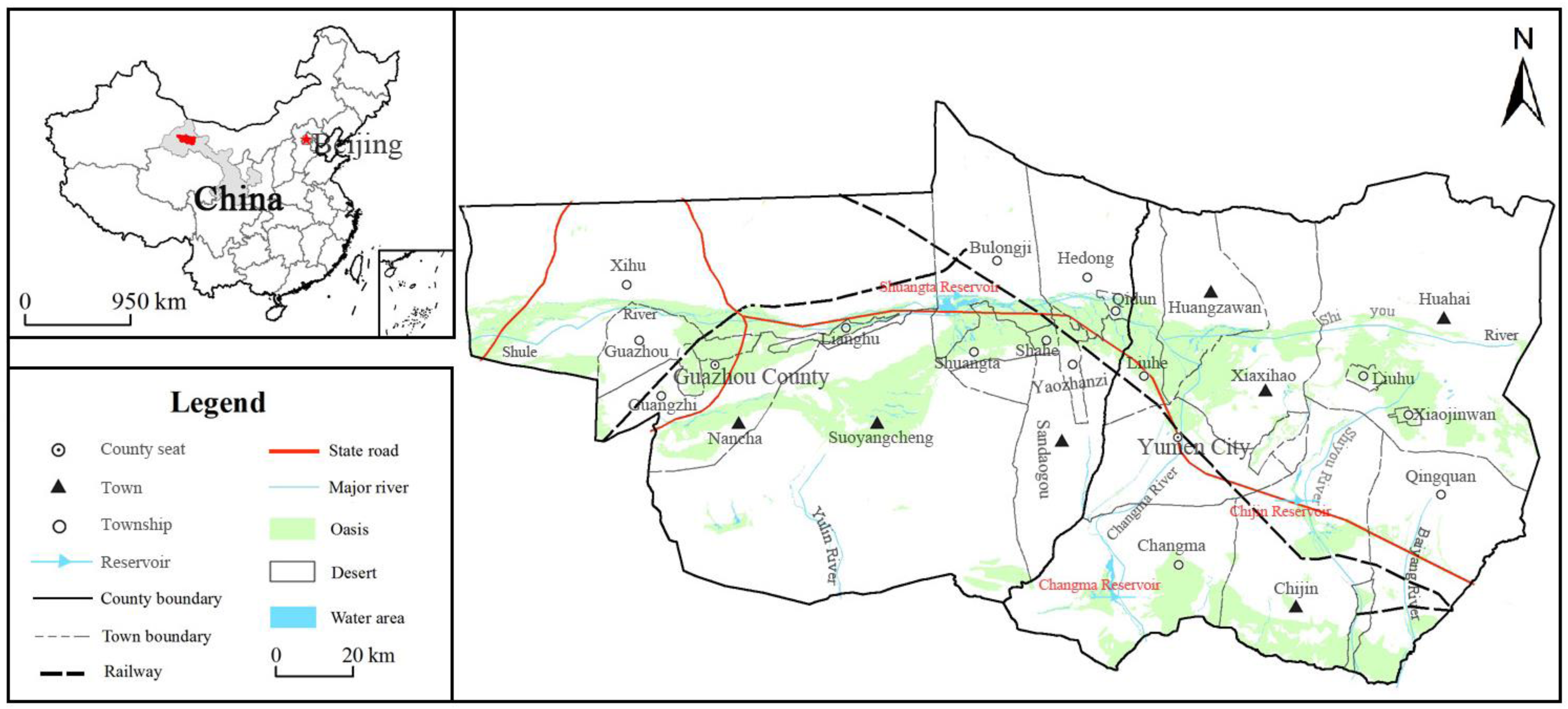

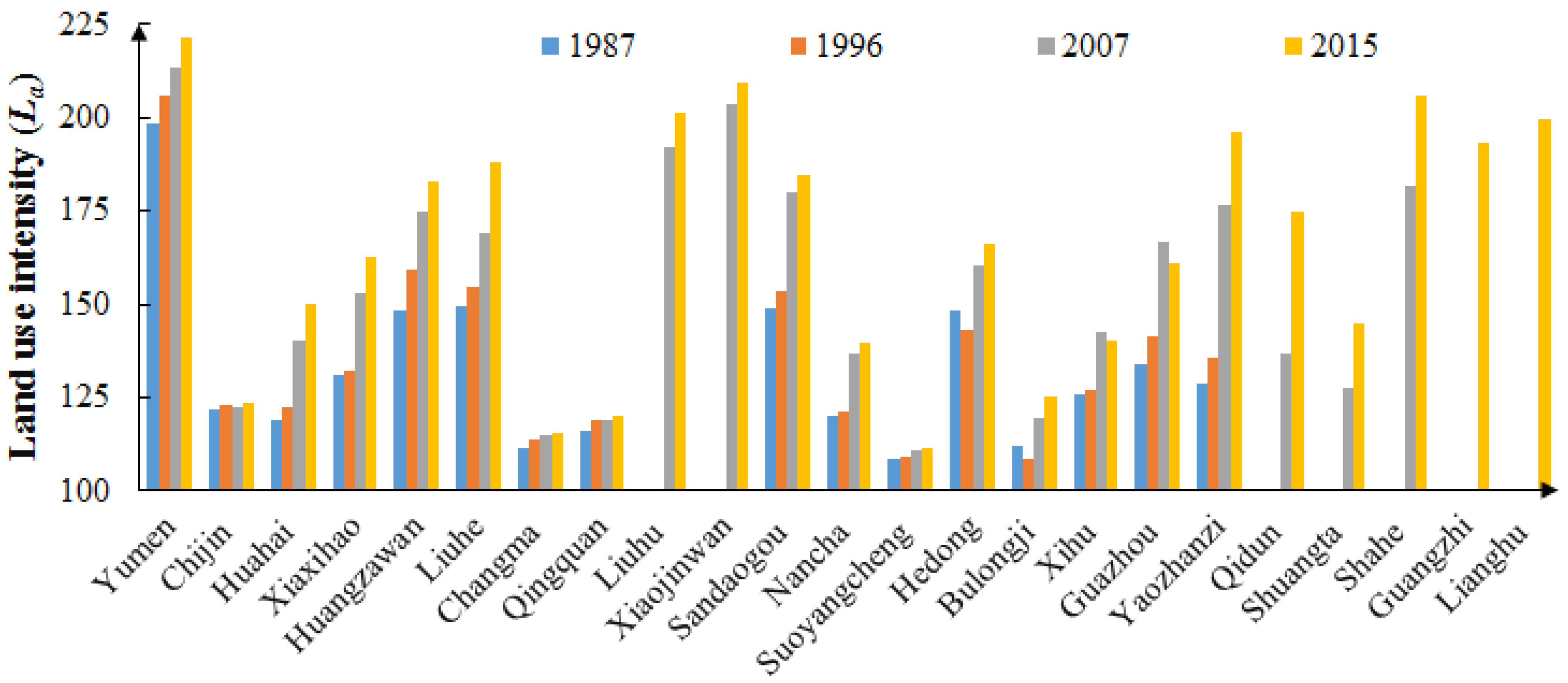
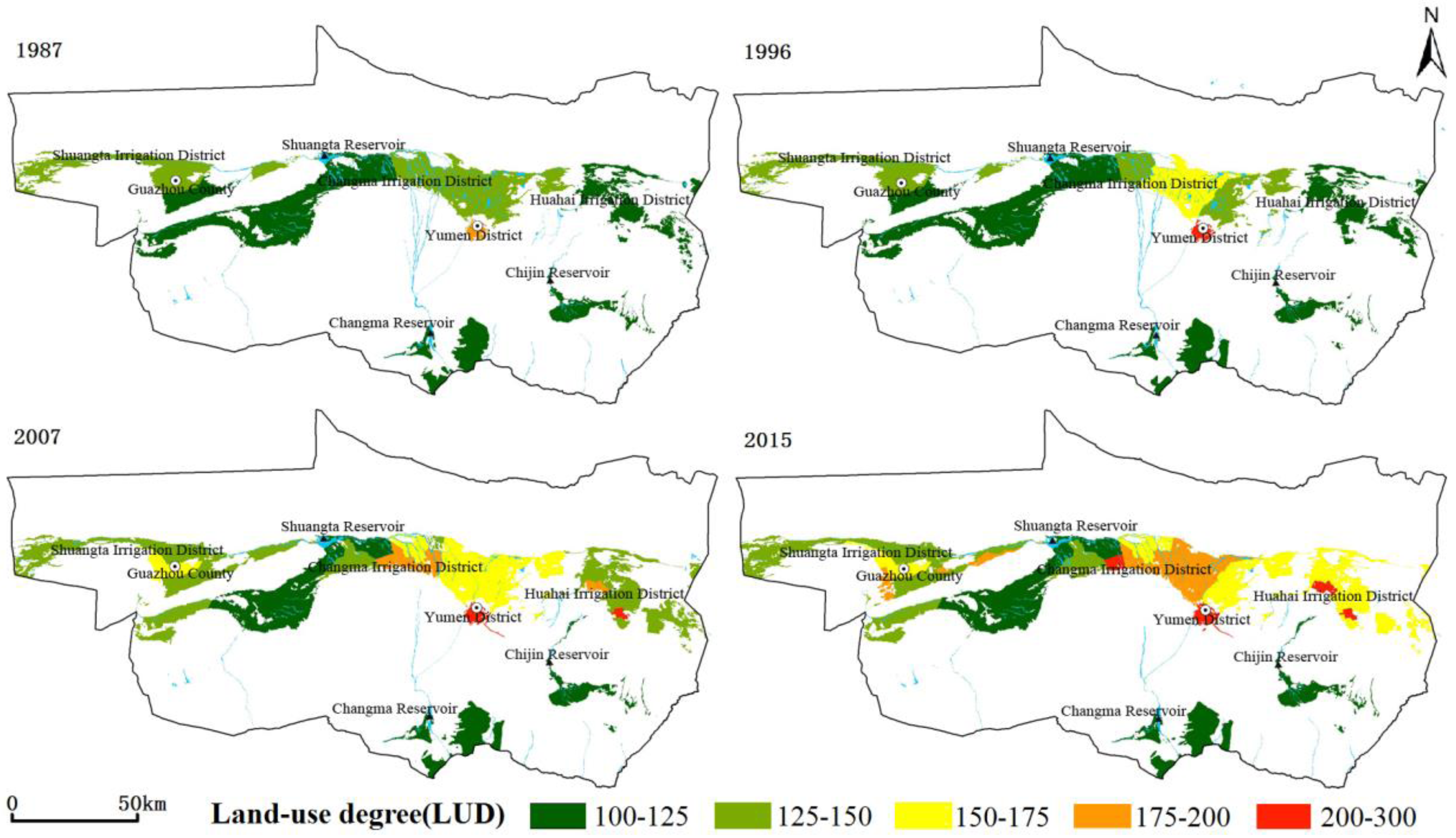
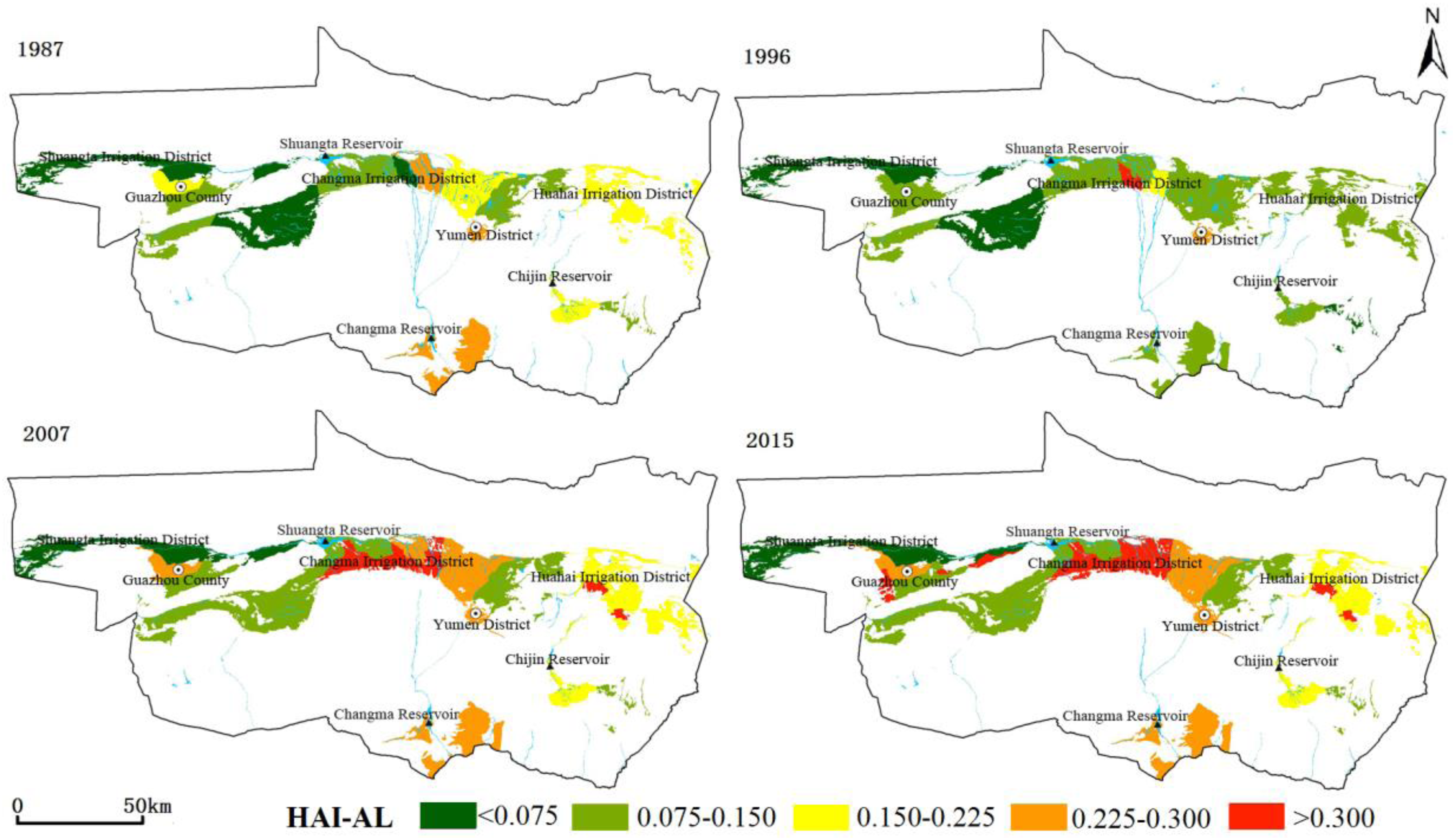
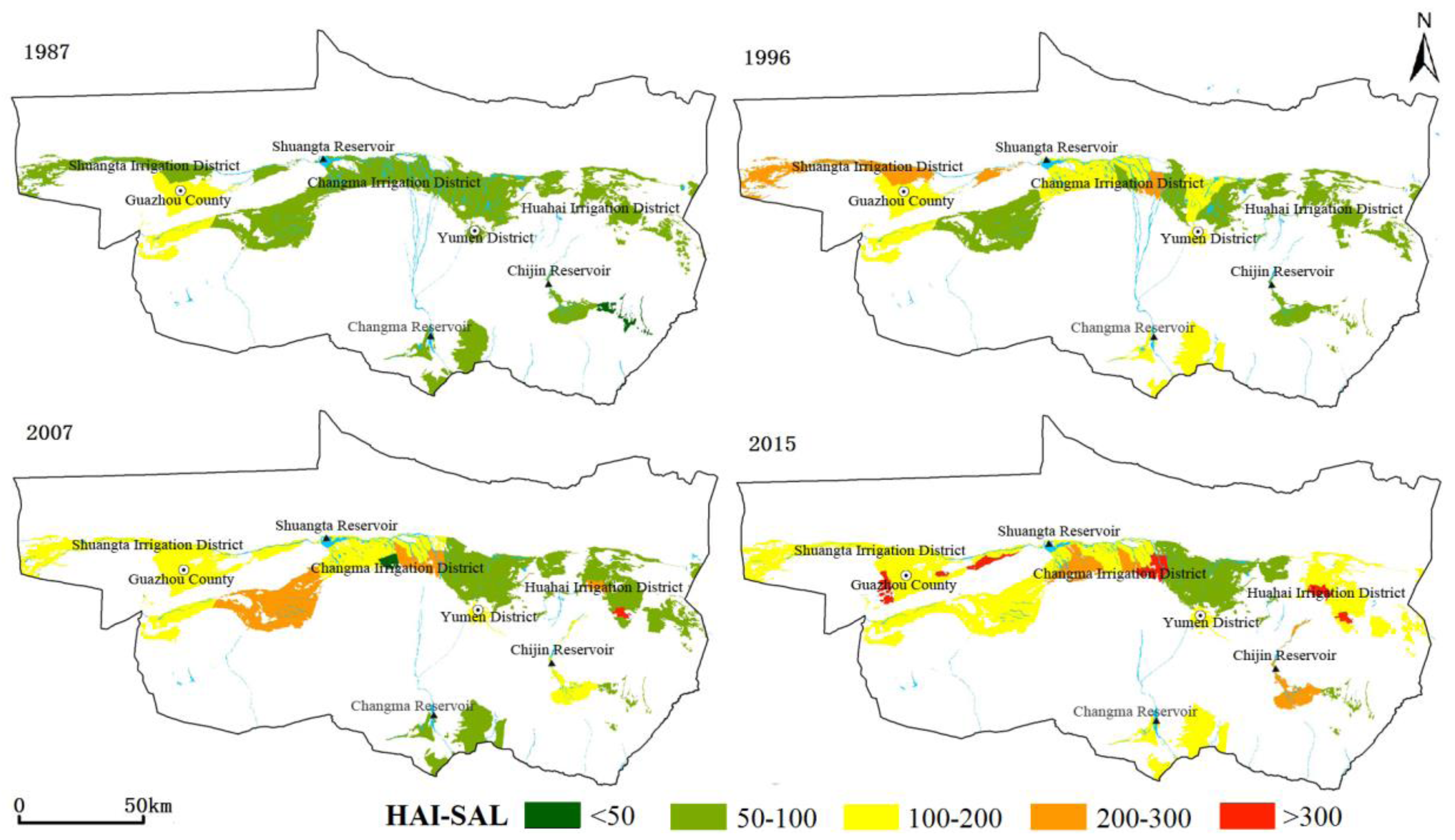
| Land Use Type | Self-Use Land | Reclaimed Land | Non-Renewable Land |
|---|---|---|---|
| Land type | Semi-natural land (woodland, grassland, wetland) | Semi-artificial land (cultivated land) | Artificial land (urban construction land) |
| Grading index | 1 | 2 | 3 |
| Land Types | 1987 | 1996 | 2007 | 2015 | |
|---|---|---|---|---|---|
| Natural land | Area (km2) | 22768.38 | 22801.22 | 22402.24 | 22219.2 |
| Proportion (%) | 83.83 | 83.95 | 82.48 | 81.81 | |
| Semi-natural land | Area (km2) | 3429.69 | 3287.94 | 3060.24 | 2911.12 |
| Proportion (%) | 12.63 | 12.11 | 11.27 | 10.72 | |
| Semi-artificial land | Area (km2) | 902.5 | 1001.11 | 1594.71 | 1880.47 |
| Proportion (%) | 3.32 | 3.69 | 5.87 | 6.92 | |
| Artificial land | Area (km2) | 59.67 | 70.18 | 103.03 | 149.43 |
| Proportion (%) | 0.22 | 0.26 | 0.38 | 0.55 | |
| Town | HAI-AL (Bi) | HAI-SAL (Pi- × 1015) | ||||||
|---|---|---|---|---|---|---|---|---|
| 1987 | 1996 | 2007 | 2015 | 1987 | 1996 | 2007 | 2015 | |
| Yumen Town | 0.250 | 0.250 | 0.250 | 0.250 | 92.53 | 123.23 | 172.61 | 151.80 |
| Chijin Town | 0.179 | 0.123 | 0.214 | 0.222 | 50.50 | 73.42 | 135.42 | 221.07 |
| Huahai Town | 0.207 | 0.096 | 0.185 | 0.212 | 66.69 | 89.43 | 83.74 | 165.16 |
| Liuhe Town | 0.164 | 0.134 | 0.282 | 0.232 | 57.56 | 96.86 | 93.23 | 80.53 |
| Xiaxihao Town | 0.133 | 0.089 | 0.133 | 0.129 | 58.01 | 80.60 | 52.65 | 53.02 |
| Huangzhawan Town | 0.165 | 0.122 | 0.237 | 0.237 | 62.06 | 108.20 | 90.56 | 79.72 |
| Changma Town | 0.250 | 0.121 | 0.250 | 0.227 | 62.42 | 113.11 | 91.36 | 133.40 |
| Qingquan Town | 0.120 | 0.071 | 0.122 | 0.119 | 48.96 | 90.64 | 97.43 | 95.84 |
| Liuhu Town | 0.461 | 0.472 | 237.81 | 631.04 | ||||
| Xiaojinwan Town | 0.558 | 0.562 | 333.90 | 348.14 | ||||
| Sandaogou Town | 0.253 | 0.175 | 0.314 | 0.380 | 98.45 | 228.04 | 296.85 | 343.84 |
| Nancha Town | 0.131 | 0.084 | 0.112 | 0.127 | 101.45 | 170.69 | 134.58 | 188.53 |
| Suoyang Town | 0.066 | 0.057 | 0.104 | 0.147 | 51.45 | 88.94 | 261.74 | 148.41 |
| Guazhou Town | 0.153 | 0.119 | 0.255 | 0.286 | 110.70 | 145.61 | 110.83 | 120.43 |
| Xihu Town | 0.074 | 0.056 | 0.062 | 0.068 | 55.89 | 217.23 | 112.79 | 122.41 |
| Yaozhanzi Town | 0.376 | 0.394 | 0.412 | 85.53 | 282.01 | 204.81 | ||
| Hedong Town | 0.236 | 0.148 | 0.283 | 0.303 | 83.95 | 161.25 | 153.99 | 170.25 |
| Bulongji Town | 0.129 | 0.088 | 0.149 | 0.141 | 68.78 | 139.41 | 108.4 | 107.21 |
| Shuangta Town | 0.377 | 0.300 | 235.54 | |||||
| Shahe Town | 0.512 | 0.493 | 99.07 | |||||
| Guangzhi Town | 0.416 | 535.84 | ||||||
| Qidun Town | 0.542 | 0.325 | 191.45 | |||||
| Lianghu Town | 0.374 | 437.26 | ||||||
© 2018 by the authors. Licensee MDPI, Basel, Switzerland. This article is an open access article distributed under the terms and conditions of the Creative Commons Attribution (CC BY) license (http://creativecommons.org/licenses/by/4.0/).
Share and Cite
Ma, L.; Cheng, W.; Bo, J.; Li, X.; Gu, Y. Spatio-Temporal Variation of Land-Use Intensity from a Multi-Perspective—Taking the Middle and Lower Reaches of Shule River Basin in China as an Example. Sustainability 2018, 10, 771. https://doi.org/10.3390/su10030771
Ma L, Cheng W, Bo J, Li X, Gu Y. Spatio-Temporal Variation of Land-Use Intensity from a Multi-Perspective—Taking the Middle and Lower Reaches of Shule River Basin in China as an Example. Sustainability. 2018; 10(3):771. https://doi.org/10.3390/su10030771
Chicago/Turabian StyleMa, Libang, Wenjuan Cheng, Jie Bo, Xiaoyang Li, and Yuan Gu. 2018. "Spatio-Temporal Variation of Land-Use Intensity from a Multi-Perspective—Taking the Middle and Lower Reaches of Shule River Basin in China as an Example" Sustainability 10, no. 3: 771. https://doi.org/10.3390/su10030771




